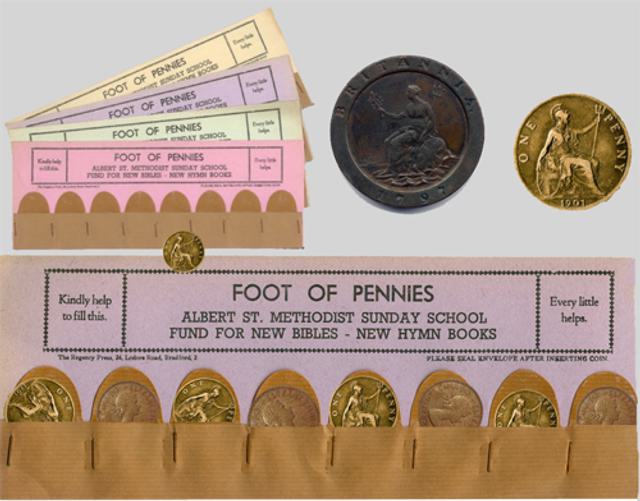Albert Street Methodist Sunday School: the foot of pennies from the 1930s
- Exhibited by
- Matt Parkes.
- Added
- September 06, 2009
- Medium of Communication
- Door-drops and householders, face to face
- Target Audience
- Individuals, single gift
- Type of Charity
- Religion related
- Country of Origin
- UK
- Date of first appearance
- Unknown
SOFII’s view
A charming, colourful device is found by chance and shows that really, there’s nothing new under the sun. As their finder explains, these fun feet of pennies are engagement devices designed to make collecting for charity easy and so to hook neophytes into the habit of giving. Thus the innovations of the distant past shed light on our more recent present. And also shine a beam that, if we are clever, will illuminate our futures.
Creator / originator
Someone from one of the many Methodist chapels found in England and Wales.
Background
In a dusty back room of a crumbling, disused Methodist chapel, in a small village near Nottingham, an old bookcase stood against a wall. Tall and dark, its years seemed to weigh even heavier than the stacks of papers that lined its shelves. The Victorian chapel, seen opposite in Google Maps, sat on a tiny plot of land. With no space to park vehicles it proved impossible to sell; its owners eventually realised that for the land to be useful the chapel had to be demolished. As the contractors moved in to start the painstaking process of taking the building down – literally brick-by-brick to avoid damaging nearby buildings – they found something unexpected in that undisturbed back room. Under one corner of the century-old bookcase, a broken leg had been replaced with a stack of what looked like sheets of coloured card. Only when the heavy brown frame was removed did they realise that a small part of England’s fundraising heritage had been discovered.
Special characteristics
A Google search reveals only two mentions of this device – both from the 1930s – one in another village near Nottingham and the other from a village near Pontypool in Wales. Both relate to fundraising for Methodist chapels. The foot of pennies was a variation on a theme still familiar today. It was a device for collecting coins that could be taken home and used in house-to-house collecting or simply in private, family offerings. In 1935, one penny was worth the equivalent of about £0.17p or 25 cents in today’s currency, meaning the foot of pennies would only raise the equivalent of £1.33 or a couple of bucks. And that’s not much more than the £1 pack of today. (Although of course one penny could probably buy more than £0.17 does now...) My hypothesis is that although it proved a useful vehicle for raising funds, it was primarily intended to work in a similar way to the £1 pack or other low value cash donation devices – by engaging the members of the community and building momentum towards regular, higher value giving.
It strikes me that, although it is indeed a foot long, it only contains eight pennies. Why not 12? The mini die-cut envelopes, each with a gummed flap, could have been stapled in two staggered rows of six. In ‘old money’, twelve pennies made a shilling, which would have seemed a more natural fundraising target. For the historians among you, 20 shillings made one pound, meaning 240 pennies in a pound – in the Anglo-Saxon years of England in the late 700s, 240 silver penny coins weighed one pound (1lb). Maybe the Methodists of the 1930s were unconcerned with price points and maximising their fundraising targets.
What they did appreciate, though, was clever design. The part-gummed, die-cut, roll-folded coin strip was stapled precisely to allow a row of pennies to be inserted. And given that in the case of this chapel, and in one of the two examples on Google, the foot of pennies was used to raise funds for Sunday schools, the coloured cards and relatively small donations would have worked well to engage a younger audience. Indeed, I wonder how many of our older donors today remember the foot of pennies.
The wording is also worth a closer look: ‘kindly help to fill this in’ and ‘every little helps’. The former is polite and direct, whilst the latter helps overcome any barriers that the small donation amount may raise. What an intriguing – if little known – piece of fundraising nostalgia.
Merits
It is part of our fundraising heritage.
 View original image
View original image
 View original image
View original image
 View original image
View original image

















